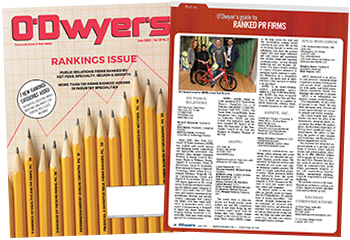 Michael Roth and Meg Wildrick co-authored this article. Michael Roth and Meg Wildrick co-authored this article. |
In early March, we witnessed a dramatic media shift as COVID-19 became the North Star of all news. The lens through which we were viewing society became mirrored in the content we were reading, hearing and seeing. Financial, sports, retail, arts and leisure, travel, real estate and, of course, healthcare news have had to maintain a connection to the global pandemic. And so, agencies began scrambling to assess their clients’ relevance to the new national conversation, while corporations focused on their core operating fundamentals and their very survival in a new world that once seemed inconceivable. For both parties, the challenge was to reset marketing messages for the new normal: testing storylines for relevance and tone while tapping into new sources of creativity and agility.
So, what went right and what could’ve been done better?
 |
| This article is featured in O'Dwyer's Jun. '20 PR Firm Rankings Magazine. |
First, the bad stuff. We’ve seen a great deal of “square peg in round hole” storytelling in paid, owned campaigns that missed the mark in terms of relevance. Messaging—some of it sounding a little desperate—came in the form of “we’re here for you” communications from the likes of automobile makers, airlines, hotel chains, cruise lines and dog food manufacturers. The good people at Frito Lay wanted you to know that their primary concern is the health and nutrition of our nation, so they’re taking action by feeding our families—with Fritos, Cheetos and Doritos—while creating jobs. Meanwhile, Hershey’s kisses recommended spreading love from a safe distance—with chocolates. Lexus went so far as to tell customers that this is time for “business as usual,” because they’ve always “put their customers first and understood their needs.”
The problem is there’s nothing usual about this moment, and claims to the contrary unintentionally tell a different story, i.e., that companies don’t want customers to abandon them during the pandemic.
Now, the good stuff. During moments of fear, loss and uncertainty, companies and agencies have an opportunity to help customers by providing them with the information, support and guidance to move forward. By engaging customers’ intellect and hearts, they create strong bonds that endure beyond the current crisis.
Brain science and effective storytelling
Studies in brain science show there are two channels in the human nervous system: one that reacts to danger/threats with a “fight or flight” response and one that responds to opportunity/purpose. We’re at our best when the two systems are in balance, prompting us to take meaningful action. The 24/7 COVID-19 news cycle throws our brains out of balance, offering up a steady stream of anxiety-producing data on infection rates, deaths, unemployment numbers, food shortages and partisan politics.
This puts us in constant panic mode and stifles our ability to move forward. On the other hand, brands that cut through the constant barrage of negative headlines help us regain balance by appealing to a shared sense of purpose.
Story themes and topics that have worked well during the crisis include:
Mental health stories focusing on the need to manage anxiety and depression. Before the pandemic, there were only pockets of mainstream regard for the negative health effects of anxiety and depression. Now, some brands are tackling these issues head-on by building awareness for the importance of mental health and offering solutions that can be accessed at home, at work and in communities.
Connection stories showcasing the benefits of face-to-face communications. Before COVID-19, loneliness was a growing—yet invisible—public health crisis. Today, tech companies, as well as tele-health and educational organizations, are offering new solutions.
Charitable giving stories celebrating access to food and shelter, health and human services and community support. Before the crisis, it was possible to turn a blind eye to the importance of low-income housing, food pantries and “shop local” initiatives. Now, there’s a heightened recognition of their importance and a collective rallying cry to provide solutions.
Guidance and direction stories helping us move beyond family and financial hardships. A number of insurance, banking and retirement companies are giving Americans of all ages and income levels easy access to tools, information and guidance resources.
Nimble adaptation stories spotlighting those racing to find treatments, produce safety equipment and fund new diagnostics and tracking tools. Car companies, entrepreneurs, public health and life sciences companies are pivoting quickly to tackle critical health and safety challenges.
Essential service stories reinforcing the value of good things we may have previously overlooked. Food companies that adhere to high quality sourcing standards, online retailers that deliver products on schedule, and healthcare professionals that work on the front lines every day: these are the heroes we no longer take for granted.
Customer service stories demonstrating a brand’s commitment to go the extra mile. While some companies have downsized or furloughed their service departments—and others have done a poor job of retaining workers amid safety concerns—a handful have doubled down and increased the attention and support they provide to customers.
Resilience stories of individuals, communities and businesses that are bouncing back from hardship and embracing a new normal.
This, of course, is an incomplete list. But it underscores a need that’s now universal: balancing fear and negativity with stories that inspire purpose and hope.
The reset moment
For all the devastation it has caused, the pandemic has also been a humanizing moment. It has reminded us of the good things we have in our lives and the bad things we need to solve for. Several writers are referring to this moment as “The Big Reset.”
“In the middle of fear, economic crisis, and social distancing there is a growing sense of closeness,” Josh Bersin wrote in Forbes. “Regardless of how soon this is over, it’s clear we are in the middle of The Big Reset, a new way of thinking about work, life, business and leadership … some are hiring; others are furloughing. But the biggest issue they face is fear in the faces of their employees.”
Brands that demonstrate genuine empathy—to employees and customers—have an opportunity to connect with stakeholders in a way perhaps previously impossible. They also have an opportunity to evolve their brand promise and lead the way forward in a post-COVID-19 era.
***
Michael Roth is Partner and Healthcare Practice Leader and Meg Wildrick is Managing Partner at Bliss Integrated Communication.


 There’s a fine line between newsjacking and taking advantage, aka ambulance chasing. Our job as PR professionals is to tread it carefully.
There’s a fine line between newsjacking and taking advantage, aka ambulance chasing. Our job as PR professionals is to tread it carefully. PR firms need to be mindful of ways their work product may be protected by the attorney-client privilege whenever working with a client’s internal legal team or its external legal counsel.
PR firms need to be mindful of ways their work product may be protected by the attorney-client privilege whenever working with a client’s internal legal team or its external legal counsel. Manuel Rocha, former US ambassador and intenational business advisor to LLYC, plans to plead guilty to charges that he was a secret agent for Cuba.
Manuel Rocha, former US ambassador and intenational business advisor to LLYC, plans to plead guilty to charges that he was a secret agent for Cuba. CEO mentoring is an often-overlooked aspect of why CEOs are able to make good decisions, and sometimes make bad ones—all of which intersects with the role and duties of a board.
CEO mentoring is an often-overlooked aspect of why CEOs are able to make good decisions, and sometimes make bad ones—all of which intersects with the role and duties of a board.  How organizations can anticipate, prepare and respond to crises in an increasingly complex world where a convergent landscape of global challenges, threats and risks seem to arrive at an unrelenting pace.
How organizations can anticipate, prepare and respond to crises in an increasingly complex world where a convergent landscape of global challenges, threats and risks seem to arrive at an unrelenting pace.


 Have a comment? Send it to
Have a comment? Send it to 
No comments have been submitted for this story yet.